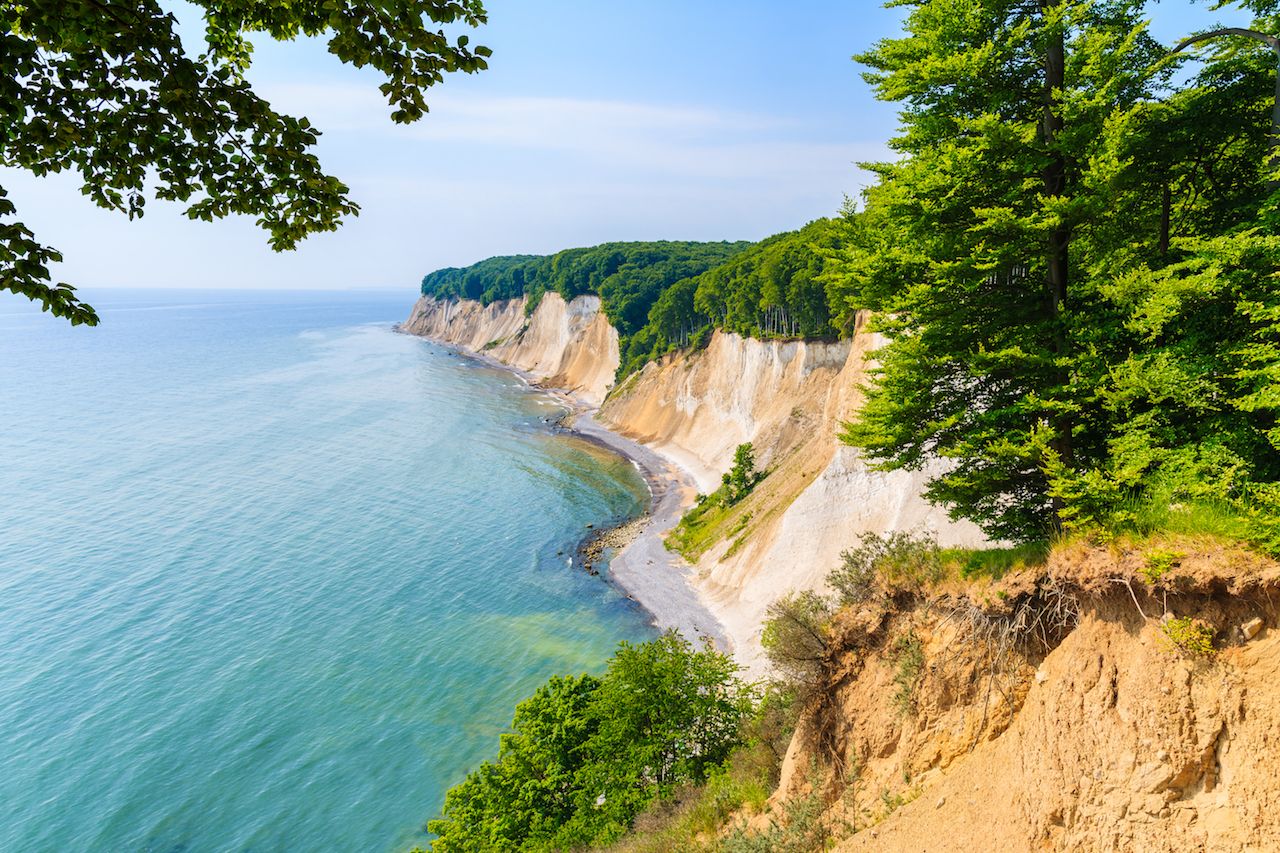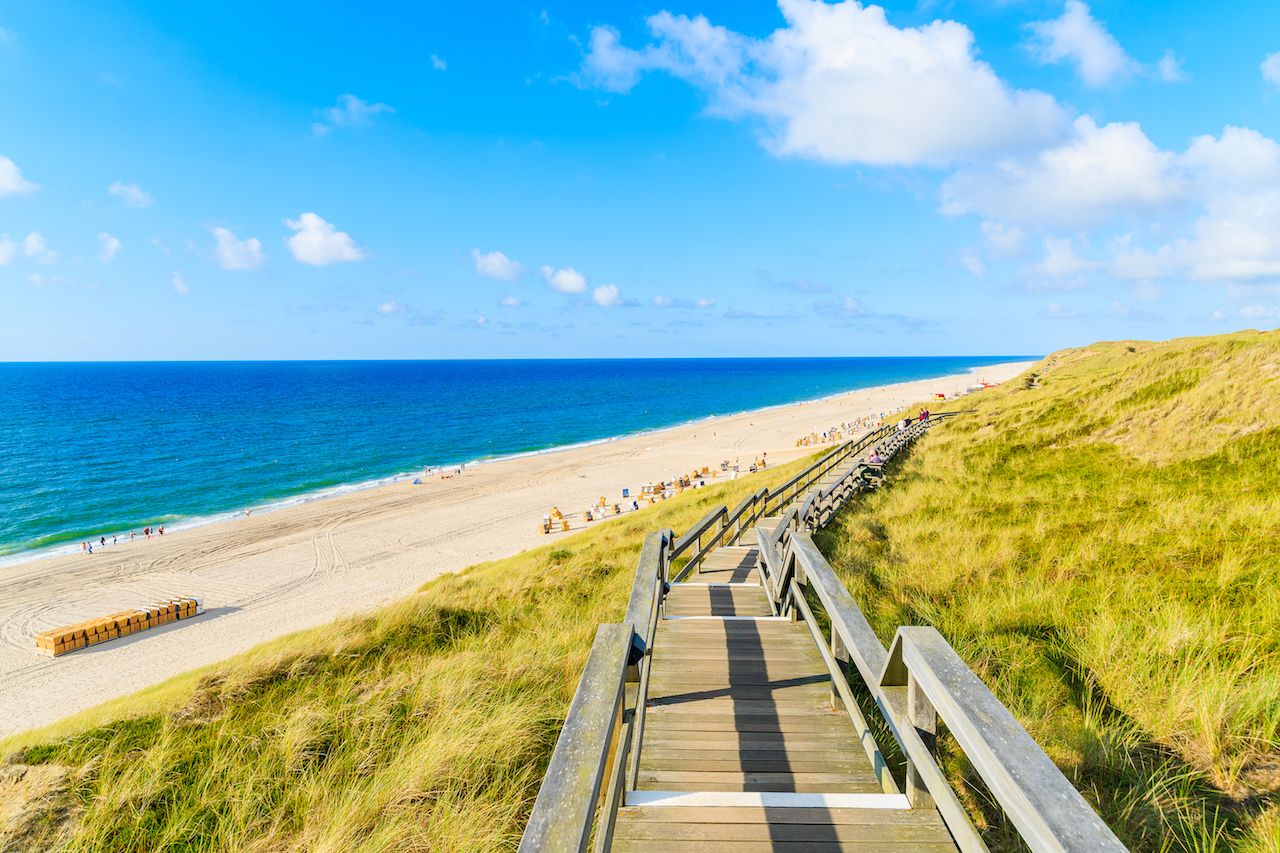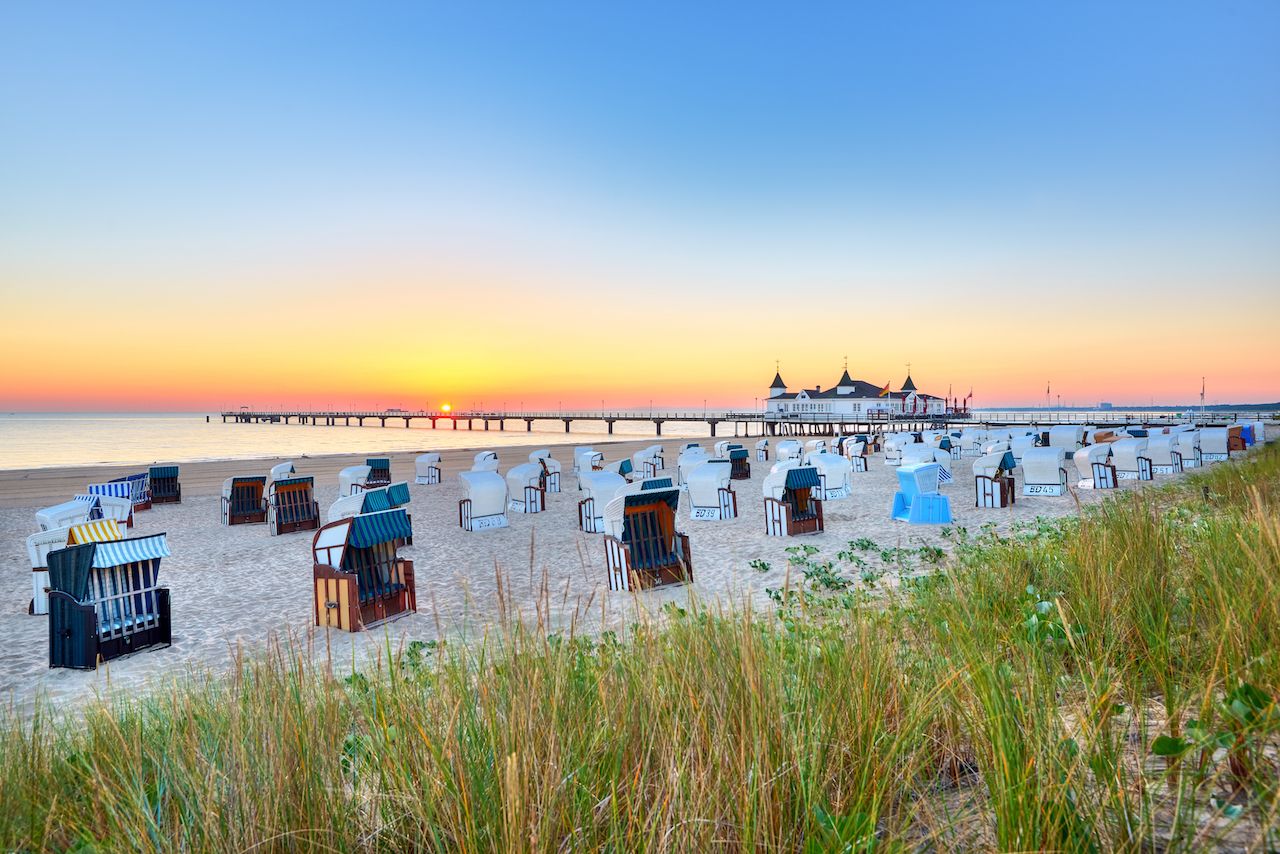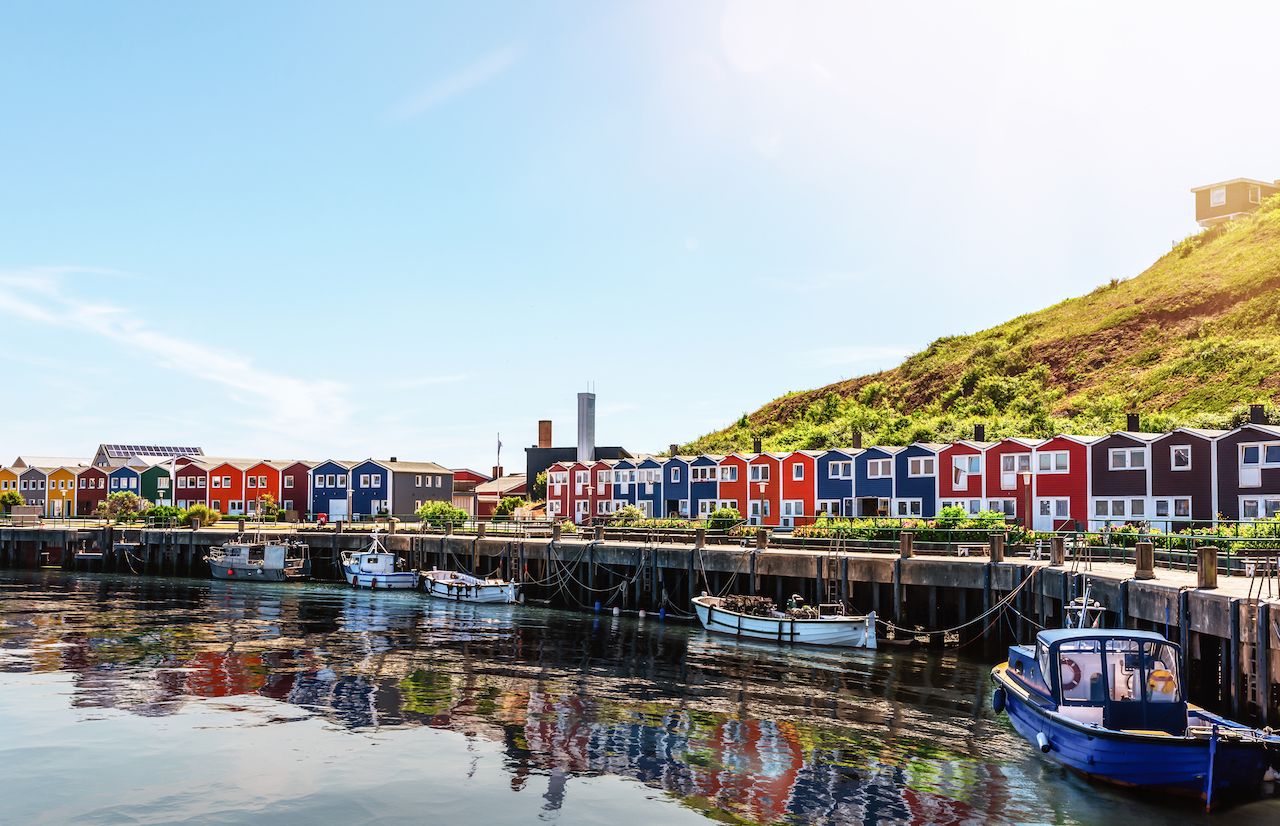Germany’s islands are the country’s most underrated spots. With coastlines along both the North Sea and the Baltic Sea, these offshore destinations are a chance to see the country in a different light and explore some of its most pristine and alluring landscapes. If you’re looking for calm waters and a chill vibe, head to the islands in the Baltic Sea. If you’re in search of wilder terrain with crisp sea breezes and crashing waves, make your way to the North Sea islands. Germany even has an island on a Bavarian lake, Lindau, that looks like a storybook town. We’ll help you make your mind with a guide to six amazing German islands that are worth checking out.


6 Gorgeous German Islands That Are Worth Visiting
1. Rügen

Photo: Pawel Kazmierczak/Shutterstock
The country’s largest island, Rügen is also the best-known German island. In recent years, this Baltic Sea destination has become a popular holiday spot due to its proximity to Berlin. Within just three or four hours from the capital, you can be relaxing in one of the many seaside resort towns on the island. Exploring the island’s impressively flat landscapes can easily be done by bike or on foot via the tree-lined paths that link the island’s elegant 19th-century resorts with seaside harbors and white sandy beaches.
Jasmund National Park, the smallest national park in all of Germany, is on Rügen. There you can hike through the UNESCO-protected beech forest towards the famous Königsstuhl, or King’s chair, which is the most majestic section of the island’s white chalk cliffs. For the best views of the cliffs, take a boat tour around the peninsula. Just a few miles to the north, Cape Arkona is also worth a visit — not only can you enter a former Cold War-era naval command bunker there, but it also yields an impressive view of the entire island.
Rügen is also home to Prora, the massive seaside resort that the Nazis built in the late 1930s as part of their Kraft durch Freude (Strength through Joy) program. Located on the most beautiful bay on the island, Prorer Wiek, the complex consists of eight large and identical buildings that stretch nearly three miles down the beach. At its peak, 20,000 people were meant to spend their holidays there simultaneously, manifesting the ethos that every working German deserves a day at the beach. Today some rooms are used as a gallery space while another section houses a small museum that explains the history of the site. The building is also home to Germany’s largest youth hostel and, after significant debate within Germany, much of the building has been or is being transformed into luxury condos and hotels.
If you’re driving from the German mainland, you can reach the island via the toll-free Rügenbrücke or Rügendamm bridges across the Strelasund channel from Stralsund. By train or bus, you can catch a direct connection from almost any nearby city using an InterCity train or a FlixBus.
Once on the island, you can jump aboard the nostalgic steam locomotive, affectionately named Rasender Roland (Racing Roland), which serves as part of the island’s public transport system. Racing Roland runs every two hours (daily) between the small towns of Putbus and Göhren, stopping in Binz, Sellin, and Baabe on the way. Railroad enthusiasts can even ride in the driver’s cab to watch the work of train drivers and stokers as the train wriggles its way across the island on its narrow railway.
2. Sylt

Photo: Pawel Kazmierczak/Shutterstock
Sylt is the largest of Germany’s East Frisian islands, located in the North Sea, and is home to over 25 miles of sandy white shores. Beginning with the first signs of spring, nearly 12,000 beach chairs (or strandkörbe) appear on the beaches and remain there until fall. For a small fee, you can rent yourself a beach basket on a daily or weekly basis and have your own personal oasis to chill. On Sylt, there is a beach for everyone, ranging from those seeking a quiet place, dog owners, and surfers to people wishing to forego their swimsuits and sunbath among the like-minded.
The island is incredibly diverse. On the west, you’ll find rough surf while on the east you’ll find the calm Wadden Sea with its tidal flats. In between, there is a vast expanse of unspoilt dunes and green dykes with wildflowers in bloom in the spring and summer. The island has 12 villages, each one with its own distinct character.
There’s plenty you can do on the island — sailing, surfing, horseback riding, cycling — but what you absolutely don’t want to miss is the opportunity to witness Sylt’s very own sport: Ring Riding. The bizarre activity consists of a rider on horseback armed with a lance riding full speed toward a brass ring that’s hardly larger than half an inch in diameter. Spearing the ring gets you a round of cheers but also some points toward earning the title of Ring Riding King or Queen. Attend a match between May and August on the east end of the island.
One of the island’s many specialties is oysters. These delicacies come directly from Dittmeyer, Germany’s only oyster farm, which is located on a 74-acre area in the Wadden Sea mudflats off the shores of the village of List. You can even pair the local seafood with a glass of the island’s wine, 55° Nord. The first vines were planted in Sylt in 2009, creating Germany’s northernmost vineyard.
You can easily get to Sylt by plane, train, or boat. International flights connect with domestic airlines for the trip to the island, and Lufthansa schedules regular flights to Sylt from Germany’s larger cities, including Munich, Hamburg, and Frankfurt. By train, you can use one of the connections from many European cities to Hamburg and take the hourly train to Sylt. Even if you want to take your car to Sylt, the final leg of your trip will be by train. The only land connection to the island is the Hindenburgdamm, a seven-mile causeway that carries train traffic from mainland Germany. Alternatively, you can hop on the Sylt Ferry, which operates year-round from Havneby to List. You can drive onto the ferry and take your car with you to Sylt, or you can travel as a walk-on passenger.
3. Usedom

Photo: Stefan Dinse/Shutterstock
This Baltic Sea island advertises itself as being one of the places in Germany that gets the most hours of sunshine every year, making it a popular vacation spot for Germans and Poles. In the summer months, lounging on the beach can easily fill up your days, but there is also a full calendar of events happening on the island. In the winter months, you’ll find ice bathing and dog sled races on the agenda; in the spring and summer, the island hosts a number of festivals, focusing on music, literature, and food. For the fitness enthusiasts, there are many cycling and triathlon events each year, which is no surprise as there are over 125 miles of cycling paths and 250 miles of hiking trails on the island.
The so-called Imperial Spas, a trio of health resorts along the seashore that used to be frequented by the German emperor Wilhelm II, are a must-see. These include Ahlbeck, Heringsdorf, and Bansin. It’s also worth spending an afternoon wandering through the historic town of Usedom itself or visiting the largest butterfly conservatory in Europe in Trassenheide.
For those looking to escape the more touristy areas of the island, you can seek out solitude among the lush forests, sparkling lakes, and fishing villages in the Achterland area of the island. You can hike or cycle through the vast moorland and salt marsh landscape, which provides a rare environment for a host of animals and plants. Worthwhile destinations in this area include the artists’ village of Benz with its art cabinet, the Dutch windmill, and the Feldstein Church. The villages of Mellenthin, Morgenitz, and Liepe with their traditional thatched-roof houses and the ports in Kamminke and Balm are also worthwhile.
Usedom is well connected to the mainland throughout the year. There are direct flights from Dortmund, Dusseldorf, Frankfurt, Stuttgart, and Zurich to the island’s airport. You can also reach Usedom from anywhere in Germany by train. InterCity trains from Hamburg and Berlin and regional trains arrive at the stations in Stralsund and Züssow. From here you can catch a Usedomer Bäderbahn connecting train, which will take you across the Wolgast bridge along the coast to every resort on the island, including the Polish city of Świnoujście.
4. Juist

Photo: dirkr/Shutterstock
With a population of just over 1,500 residents, this cozy little North Sea island is just 4.5 miles from the German mainland and the perfect retreat spot. The island itself is home to a number of natural wonders, ranging from the endangered bird species that nest there to the seal colonies that can be found basking in the sun on the island’s western beaches. In between, you can find endless rolling dunes and white-sand beaches to explore.
When the tide has gone out, you can walk along the ocean floor for miles where the North Sea and the Wadden Sea meet. However, be sure to check the tide times before venturing out or explore the area with a licensed guide. The tide tends to come in quickly and, when coupled with a sudden rise in sea fog, can make for a dangerous situation.
If you’re heading out for the day — hiking, cycling, or on a horse and carriage ride — Domäne Bill on the western side of the island is the perfect destination for a bite to eat. This former farm turned restaurant serves homemade specialities, including a delicious, sweet white bread with raisins and butter.
With only two small villages on the island, Loog and Juist are where most of the main attractions can be found. This includes several wellness and spa centers known for their use of Thalassotherapy. On the southern coast of the island, there’s a selection of high caliber bars and restaurants, as well as the opportunity to rent sailboats or jump aboard a boat for an excursion to a neighbouring East Frisian island.
There are no cars on the island, only bicycles and horse-drawn carriages. The island itself is only 10 miles long and a mere 0.3 miles wide at its narrowest point, so it’s easy to get around. There are plenty of bike rental facilities in the two main villages.
Getting to Juist shouldn’t cause you to worry. The island has its own airport with FLN-Frisia Luftverkehr offering scheduled service between the mainland and the other Frisian islands. Most visitors, however, take the ferry from Norddeich on the mainland to the island, with services arriving daily and taking just over an hour each way.
5. Langeoog

Photo: ThomBal/Shutterstock
With a population only slightly larger than that of Juist, Langeoog is another one of Germany’s East Frisian islands. Emblazoned on postcards, hats, and t-shirts, the quirky little island has proudly embraced the motto: “No sharks, no cars.” Even if cars were allowed on the island, you wouldn’t need one — everything on Langeoog is within walking distance.
A trip to Langeoog is about spending time outdoors. The island has nine miles of white-sand beaches and undulating terrain of sand dunes, some of which stand 66 feet high. There are many cycling and hiking paths that lead visitors around the entire island, passing sandy beaches, salt marshes, and dune landscapes. Cyclists can easily cover the length of the island in a day, riding to the island’s easternmost point to watch seals and birds from the vantage point of a nature lodge. The restaurant and bar Meierei, also on the east end of the island, offers a rustic atmosphere where you can enjoy a quick beer and some German snacks before leisurely making your way back to the town center.
In the summer, there are a number of day trips you can arrange from the island. These include boat excursions to neighbouring islands or to visit the seals on the island’s eastern edge. You can also participate in a wide range of island activities, such as water sports, yoga on the beach, or even joining the choir that meets weekly amidst the dunes for a sing-a-long under the stars. In town, a stop at Teerose Langeoog will provide you with the perfect opportunity to try the region’s famous East Frisian tea ceremony.
Like the other East Frisian islands, Langeoog has a large thalassotherapy wellness center for rainy days, as well as a quaint living-room-sized cinema if you’re looking to get your film fix while on vacation.
To arrive in Langeoog, you must first reach Bensersiel. This can be done by car, by taking a train to Esens and then the bus to Bensersiel, or arriving directly there with FlixBus. You’ll then purchase your Langeoog Card, which allows you access to the ferry which shuttles between Langeoog and Bensersiel around five times daily. The ferry ride takes about 35 minutes. Upon arrival on the island, a rainbow-colored train will take visitors, and their luggage, from the harbour into the heart of the city within five to 10 minutes.
6. Heligoland

Photo: Christian Horz/Shutterstock
Heligoland is located about 40 miles off the mainland and is the only German island in the high seas. The island is actually made up of two parts: one populated, the other one home only to an iconic sandstone dune. The two islands were connected until 1720 when they were severed by an intense sea storm.
The island itself has a fascinating past. Over the years, it’s changed hands between the Danish, British, and Germans. It served as a strategic German naval base for both World Wars and was heavily bombed during and after the Second World War by the British army.
Today, the island sees a lot of day-trippers, but visitors can also stay overnight at one of the many hotels. Spending a few days on this car-free island will allow you enough time to visit the iconic Lange Anna (Tall Anna), a 154-foot-high pinnacle that juts out of the sea. You can also visit WWII bunkers or the local museum to learn more about the history, enjoy the maritime air by following some of the island’s many hiking paths, and even say hello to the resurging numbers of Atlantic seals that can often be found relaxing on the island’s shores.
While on Heligoland, eat all of the fresh seafood you can. You can even wash it down with the Heligolander Eiergrog, a local drink made from brown and white rum, hot water, and egg.
The easiest way to reach Heligoland is to take a ferry from Hamburg, Cuxhaven, or Bremerhaven. It is best to check the times regularly as changes to departure times and cancellations often occur due to unpredictable weather patterns in the region.